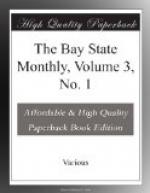Without doubt the love for historical literature was quickened by the kind patronage of John Farmer, the genial historian, who was a visitor at the Boscawen farm-house, and who had delightful stories to tell of the exploits of Robert Rogers and John Stark during the French and Indian wars.
Soldiers of the Revolution were living in 1830. Eliphalet Kilburn, the grandfather of Charles Carleton Coffin on the maternal side, was in the thick of battle at Saratoga and Rhode Island, and there was no greater pleasure to the old blind pensioner than to narrate the stories of the Revolution to his listening grandchild. Near neighbors to the Coffin homestead were Eliakim Walker, Nathaniel Atkinson and David Flanders, all of whom were at Bunker Hill—Walker in the redoubt under Prescott; Atkinson and Flanders in Captain Abbott’s company, under Stark, by the rail fence, confronting the Welch fusileers.
The vivid description of that battle which Mr. Coffin has given in the “Boys of ’76,” is doubtless due in a great measure to the stories of these pensioners, who often sat by the old fire-place in that farm-house and fought their battles over again to the intense delight of their white-haired auditor.
Ill health, inability for prolonged mental application, shut out the future correspondent, to his great grief, from all thoughts of attempting a collegiate course. While incapacitated from mental or physical labor he obtained a surveyor’s compass, and more for pastime than any thought of becoming a surveyor, he studied the elements of surveying.
There were fewer civil engineers in the country in 1845 than now. It was a period when engineers were wanted—when the demand was greater than the supply, and anyone who had a smattering of engineering could find employment. Mr. Coffin accepted a position in the engineering corps of the Northern Railroad, and was subsequently employed on the Concord and Portsmouth, and Concord and Claremont Railroad.
In 1846 he was married to Sallie R. Farmer of Boscawen. Not wishing to make civil engineering a profession for life he purchased a farm in his native town; but health gave way and he was forced to seek other pursuits.
He early began to write articles for the Concord newspapers, and some of his fugitive political contributions were re-published in Littell’s Living Age.
Mr. Coffin’s studies in engineering led him towards scientific culture. In 1849 he constructed the telegraph line between Harvard Observatory and Boston, by which uniform time was first given to the railroads leading from Boston. He had charge of the construction of the Telegraphic Fire Alarm in Boston, under the direction of Professor Moses G. Farmer, his brother-in-law, and gave the first alarm ever given by that system April 29, 1852.




